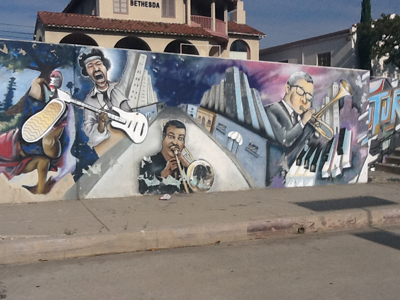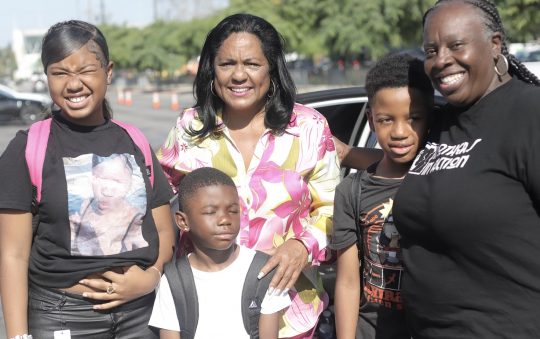
Crenshaw Mural photos by Ashley Nash
Also featured within the Crenshaw Mural of African American Progress are pioneers Malcolm X, Dr. Martin Luther King Jr., The Black Panthers and more.
Initiating the second half of praised pioneers is human rights activist and minister, Malcolm X.
Recognized as an advocate for the African-American community, X “held White America accountable.” With a family history pierced by discrimination and prejudice, X encountered much tragedy before rising to the occasion.
Despite the tragedy and hardship, he went on to join the Nation of Islam, subsequently founding organizations such as the Muslim Mosque Inc., and the Organization of Afro-American Unity. In his advocacy for the Black community, X demanded that Blacks begin to promote and support themselves. Through international travel and encounters with leaders of other countries, X strengthened his teachings and beliefs. Still considered one of the most influential Black people of all time, Malcolm X had great involvement in the uplifting of self-esteem and productivity within Black communities across the United States. Also in pursuit of this undertaking was Dr. Martin Luther King Jr., activist and African-American Civil Rights leader.
As a Baptist minister, King famously led the Bus Boycott in Montgomery, Alabama. Later, in 1963 he delivered “I Have a Dream,” from the Lincoln Memorial steps in Washington D.C., one of the most uplifting and hopeful speeches of all time. Equally, these actions warranted his being classified not only as a radical, but also as an African-American Star of Promise. With many influences sharing and affecting his same dream of nonviolent unity, King was not only an advocate of the Black Community, but of people as a whole. Sharing in his passion of Black promotion was The Black Panther Party.
According to the Black Panther website, the legacy is described as “a progressive political organization that stood in the vanguard of the most powerful movement for social change in America since the Revolution of 1776 and the Civil War…the sole black organization in the entire history of black struggle against slavery and oppression in the United States that was armed and promoted a revolutionary agenda…” While many considered them a threat to the well-being of the United States of America, their objectives and goals aligned with that of their predecessors: achieving equality for Black America. Although methods varied amongst Black figures, the desire(s) remained the same.
Introducing a new way to combat inequality and lift voice were the actions and songs of legendary musician, Jimi Hendrix. Deemed one of the most adored figures of the 1960s era, Hendrix broke ground in guitar and the music world in general. Teaching himself to play guitar as a teenager, he achieved great success leaving behind an unmatched legacy, and copious following.
Influencing this Rock’n’Roll great was the prominent and facially recognizable, Dizzy Gillespie. As a pioneer of bebop (in accordance with the Dizzy Gillespie webpage), the musical great is also acknowledged as principal trumpeter of various rhythms such as Afro-Cuban and Brazilian. As all listeners weren’t advocates of his harmonic adventurousness, Gillespie still distinguished several bands merely with his participation.
As a result, he served as the first jazz artist to travel and represent America in his musicianship and community connection.
What better note to end on! The legacy defined by the pioneers included in the Crenshaw Mural of African American progress is one that should be celebrated, and tastefully embodied. Here in our own community we have a legacy to remember and by which we should stay encouraged. As these pioneers have highlighted our pathway to success, let’s continue to highlight them!







